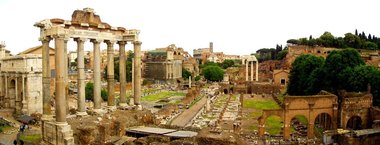Roman Forum
|
|
Missing image Forum_Romanum_panorama.jpg Roman Forum with Palatine Hill in the background. |
The Roman Forum (Forum Romanum, although the Romans referred to it more often as the Forum Magnum or just the Forum) was the central area around which ancient Rome developed, in which commerce, business, trading and the administration of justice took place. Here the communal hearth was located. Sequences of remains of paving show that sediment eroded from the surrounding hills was already raising the level of the forum in early Republican times. Originally it had been marshy ground, which was drained by the Tarquins with the Cloaca Maxima. Its final travertine paving, still to be seen, dates from the reign of Augustus.
It is now famous for the remains, which eloquently show the use of urban spaces during the Roman Age. The Roman Forum includes the following major monuments, buildings and other ancient ruins:
- Temple of Castor and Pollux
- Temple of Jupiter
- Temple of Saturn
- Temple of Vesta
- Basilica Aemilia
- Basilica Julia
- Arch of Septimius Severus
- Arch of Titus
- Rostra
The last monument built inside the Forum is the Column of Phocas.
During the Middle Ages, though the memory of the Forum Romanum persisted, its monuments were for the most part buried under debris, and its location was designated the Campo Vaccinio or "cattle field," located between the Capitoline Hill and the Colosseum. The return of Pope Urban V from Avignon (1367) led to an increased interest in ancient monuments, partly for their moral lesson and partly as a quarry for new buildings being undertaken in Rome after a long lapse. Artist from the late 15th century drew the ruins in the Forum, antiquaries copied inscriptions from the 16th century, and a tentative excavation was begun in the late 18th century. But the excavation by Carlo Fea, who began clearing the debris from the Arch of Septimius Severus in 1803, and archaeologists under the Napoleonic regime marked the beginning of clearing the Forum, which was only fully excavated in the early 20th century.
Other fora existed in other areas of the city; remains of most of them, sometimes substantial, are extant.
- The most important of these are a number of large imperial fora forming a complex with the Forum Romanum: the Forum Julium, Forum Augustum, the Forum Transitorium (also: Forum Nervae), and Trajan's Forum.
- The Forum Boarium was dedicated to the commerce of cattle and was between the Palatine Hill and the river Tiber.
- The Forum Holitorium was dedicated to the commerce of herbs and vegetables, between the Capitoline Hill and the Servian walls.
- The Forum Piscarium was dedicated to the commerce of fish, between the Capitoline hill and the Tiber, in the area of the current Roman Ghetto.
- The Forum Suarium was dedicated to the commerce of pork, near the barracks of the cohortes urbanae in the northern part of the campus Martius.
- The Forum Vinarium was dedicated to the commerce of wine, in the area now of the "quartiere" Testaccio, between Aventine Hill and the Tiber.
- Other markets were known, but not correctly identifiable because of either lack of clear information or plurality of sites. Among these, the Forum cuppedinis, for generic commerce of many kinds of goods.
See also
External links
- "Forum Romanum", a ThinkQuest site (http://intranet.grundel.nl/thinkquest/introduction.html)
- Christian H? The Roman Forum (http://penelope.uchicago.edu/Thayer/E/Gazetteer/Places/Europe/Italy/Lazio/Roma/Rome/Forum_Romanum/_Texts/Huelsen*/home.html) (at LacusCurtius; H?was one of the principal excavators of the Forum)
- Forum Romanum (http://penelope.uchicago.edu/Thayer/E/Gazetteer/Places/Europe/Italy/Lazio/Roma/Rome/_Texts/PLATOP*/Forum_Romanum.html) (at LacusCurtius; article in Platner's Topographical Dictionary of Ancient Rome)
- "Forum Romanum" Project at VRoma (http://www.vroma.org/~forum/)


